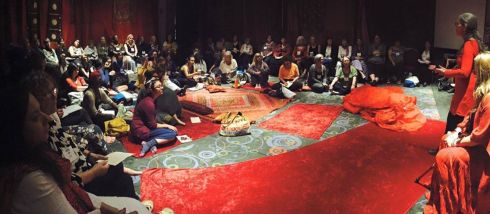The Parliament of the World’s Religions was held on October 15-19, 2015 in Salt Lake City, UT. Roughly 10,000 people attended this year’s event, representing hundreds of nations and over 50 faith traditions. Attendees included academics engaged in roundtable talks of peace, disarmament, conflict resolution and climate change; leaders of various faith communities (Christian, Buddhist, Hindu, Muslim, Jewish, pagan, indigenous, interspiritual and more) committed to spreading peace and compassion in the world; as well as spiritual seekers and activists dedicated to healing their own communities from within and using interfaith dialogue to bridge some of those divides.
Guest speakers and panelists included biologist Jane Goodall, author Karen Armstrong, activist Eboo Patel, New Thought minister Michael Bernard Beckwith, Sojourners founder Jim Wallis, and many more, including His Holiness the Dalai Lama, who fell ill at the last minute and had to return home.
Several impromptu groups and coalitions were formed during and after many of the lively discussions and plenaries in order to leverage the momentum created at this historic event. The halls of the Salt Palace Convention Center stayed active and alive all weekend long with talks of peace, interfaith harmony and global awakening.
HIGHLIGHTS
The theme of this year’s Parliament was “recovering the heart of humanity.” With the overwhelming (and refreshing) presence of the Inaugural Women’s Assembly, the focus on indigenous peoples, and the continued conversation around climate change, much of the event was spent turning social issues and recently-identified problems into concrete actions or takeaways.
The Assembly kicked off the Parliament on Thursday with a rousing closing speech from author and recent congressional candidate, Marianne Williamson. Williamson addressed the majority of female leaders in the crowd (a notable shift from the last Parliament, held in 2009) by saying, “We are the mothers of the world. Those who are inspired by the religions of the world should not ignore the problems of the world. We know how to hold the suffering in the world. We know how to give birth to the radical joy in the world.” And referring to increased violence and corruption across the globe, she got the crowd on their feet when she implored, “We who are the mothers of the world — it’s up to us to say, ‘this will not be happening in my house.'”
The Red Tent Movement (based on the popular book by Anita Diamant), was the sponsor of the Women’s Sacred Space. Men were welcome to enter the gauzy, red room (a meeting room modified to resemble the inside of a darkened, Persian tent and lovingly referred to as the “womb of the Parliament”), but when the doors would occasionally burst open releasing huge crowds back into the flow of the bustling hallways, most everyone I saw was female — and they were beaming. It was like a charging station for the female soul.
Stories circulated about The Indigenous Grandmothers — a group of female elders from the various tribes present at the Parliament. If you were lucky enough to fall in with this group, you were treated to prayers, songs and dances from various faith traditions; entrusted into a circle of maternal power forged by language and culture; and part of a historic, once-in-a-lifetime gathering. As these languages and cultural practices shrink from the earth (some are simply gone forever), the Grandmothers seemed to plant what remaining seeds they had.
A traditional Langar (community meal that is shared regardless of faith or caste) was served every day to conference attendees by the Sikh community who donated all the food and volunteered their time each day to prepare, serve and clean up. The menu was a rotating blur of rice, lentils, curry, naan, yogurt, fruit, vegetables, coffee and chai tea. People lined up each day at noon (hair covered and shoes removed) to be seated on the floor in long rows and share a meal with strangers and newfound friends. Each day the line was longer, as word spread of the fragrant Basmati rice and spicy lentils. Truly one of the best meals I’ve had. After the event, nearly 1,000 lbs. of leftover food was donated to a local Catholic charity that served the homeless.
Alas, not everything at the Parliament came up roses and rainbows. On Friday, the Council on Foreign Relations sponsored a luncheon at the Marriott which featured Farah Pandith and Graeme Wood (the journalist who wrote the recently-gone-viral article for The Atlantic, “What ISIS Really Wants”). The session was moderated by Lee Cullum. By the time the Q&A began, the attendees (who had already been fed) were restless. Some in the crowd weren’t satisfied with the positions taken by Pandith and Wood and became combative. Cullum pulled the plug on the session, ending it early.
FRIDAY
Former Catholic priest and iconoclastic author, the Rev. Dr. Matthew Fox, was on hand Friday to lead 300 or so lucky people in a Cosmic Mass. And those who had managed to squeeze into Ballroom H were treated to a transformative experience.
The Cosmic Mass is typically held in Oakland, CA and resembles a Catholic mass but with a 21st century twist. It includes electronic music, video projection, and ecstatic dance as well as prayer, communion, and a grieving ritual which asks attendees to get on all fours and moan until they are emptied of their suffering.
I had run into Fox’s assistant and director of The Cosmic Mass, Skylar Wilson, on Friday morning. I had offered my services, and was promptly given the job of puppeteering the Green Man during the Cosmic Mass event. The Green Man was a huge disembodied papier-mâché head on a pole, draped in green gauze and flanked by two large hands, also on poles. The figure required three people to operate. The Green Man was accompanied by a second puppet — the female figure, Gaia (Mother Earth). These two gigantic puppets (created by Mary Plaster) in their full splendor on the dance floor, represented the union of the sacred masculine and the divine feminine.
Fox began the ceremony by providing a brief introduction to his Creation Spirituality movement. This teaching includes a belief in a spiritual connection to the earth, a replacement of the concept of “original sin” with “original blessing” and the four paths of the via positiva, via negativa, via creativa and via transformativa, which align with the cardinal directions of north, south, west and east.
There was an invocation, a calling-in of the directions, music and drumming (including a standout vocal performance by Michelle Jordan), the grieving ritual, a reading of Neil Douglas-Klotz’s Prayer of the Cosmos, and the “passing of the peace” (in which attendees wandered the room, touched hands, and greeted each other with “namaste”).
Then it was time for the dance. The Green Man and Gaia, powered by their six volunteers, took to the dance floor and swayed and pumped to the pulsating electronic rhythm until the event was over.
As a leader of spiritual community, The Cosmic Mass was a revelation. It was a religious experience like none other — connecting everyone in attendance directly to each other and to the Source of all. It held the elements of masculine and feminine power in exquisite balance and oriented us to the cycles of the season (not only in the world, but in our own hearts). It was joyous, heart-breaking, contemplative and awe-inspiring. It also is ceremony and ritual that proudly wears the clothing of 2015 (video, technology, social media). For those who are seeking a post-modern worship experience, one that as Fox likes to say is rooted not is “text” but in “context,” then the Cosmic Mass is that experience. It will keep me fed for the upcoming year (or until I can experience it again).
That evening, I had the honor of being invited to dinner with the association of Creation Spirituality Communities and learned more about how Fox’s teachings were being implemented in churches and religious communities in Pittsburgh, Asheville, Austin, Toronto and beyond. Continue reading







 stronomically speaking, Litha (Midsummer, Gathering Day, Summer Solstice) is the longest day of the year, representing the Sun God at his full power and utmost potential. In the sky overhead, ruling from on high — in his chariot, shining down upon us, giving light, heat and life to our Goddess, Mother Earth.
stronomically speaking, Litha (Midsummer, Gathering Day, Summer Solstice) is the longest day of the year, representing the Sun God at his full power and utmost potential. In the sky overhead, ruling from on high — in his chariot, shining down upon us, giving light, heat and life to our Goddess, Mother Earth.





